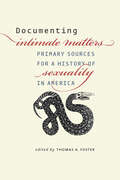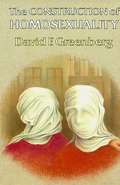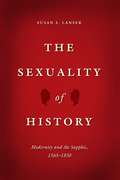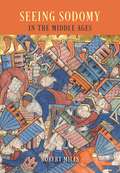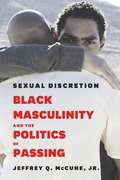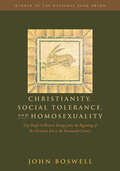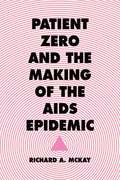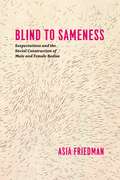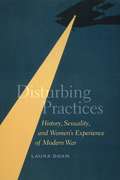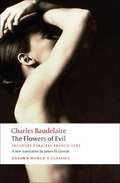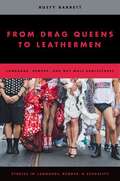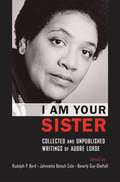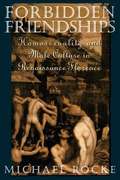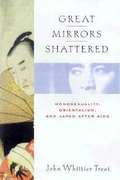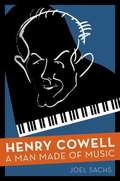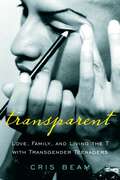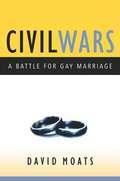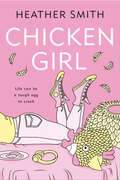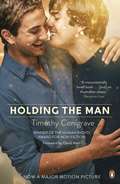- Table View
- List View
Documenting Intimate Matters: Primary Sources for a History of Sexuality in America
by Thomas A. Foster“Thorough, and timely . . . sure to be a popular and valued companion to courses on the history of sexuality and gender in the United States.” —Regina Kunzel, University of MinnesotaOver time, sexuality in America has changed dramatically. Frequently redefined and often subject to different systems of regulation, it has been used as a means of control; it has been a way to understand ourselves and others; and it has been at the center of fierce political storms, including some of the most crucial changes in civil rights in recent years. Edited by Thomas A. Foster, Documenting Intimate Matters features seventy-two documents that collectively highlight the broad diversity inherent in the history of American sexuality.Complementing the third edition of Intimate Matters, by John D’Emilio and Estelle B. Freedman—often hailed as the definitive survey of sexual history in America—the multiple narratives presented by these documents reveal the complexity of this subject in US history. The historical moments captured in this volume show that, contrary to popular misconception, the history of sexuality is not a simple story of increased freedoms and sexual liberation, but an ongoing struggle between change and continuity.
The Construction of Homosexuality
by David F. Greenberg"At various times, homosexuality has been considered the noblest of loves, a horrible sin, a psychological condition or grounds for torture and execution. David F. Greenberg's careful, encyclopedic and important new book argues that homosexuality is only deviant because society has constructed, or defined, it as deviant. The book takes us over vast terrains of example and detail in the history of homosexuality."—Nicholas B. Dirks, New York Times Book Review
The Sexuality of History: Modernity and the Sapphic, 1565–1830
by Susan S. LanserThe period of reform, revolution, and reaction that characterized seventeenth- and eighteenth-century Europe also witnessed an intensified interest in lesbians. In scientific treatises and orientalist travelogues, in French court gossip and Dutch court records, in passionate verse, in the rising novel, and in cross-dressed flirtations on the English and Spanish stage, poets, playwrights, philosophers, and physicians were placing sapphic relations before the public eye. In The Sexuality of History, Susan S. Lanser shows how intimacies between women became harbingers of the modern, bringing the sapphic into the mainstream of some of the most significant events in Western Europe. Ideas about female same-sex relations became a focal point for intellectual and cultural contests between authority and liberty, power and difference, desire and duty, mobility and change, order and governance. Lanser explores the ways in which a historically specific interest in lesbians intersected with, and stimulated, systemic concerns that would seem to have little to do with sexuality. Departing from the prevailing trend of queer reading whereby scholars ferret out hidden content in “closeted” texts, Lanser situates overtly erotic representations within wider spheres of interest. The Sexuality of History shows that just as we can understand sexuality by studying the past, so too can we understand the past by studying sexuality.
The Sexuality of History: Modernity and the Sapphic, 1565-1830
by Susan S. LanserThe period of reform, revolution, and reaction that characterized seventeenth- and eighteenth-century Europe also witnessed an intensified interest in lesbians. In scientific treatises and orientalist travelogues, in French court gossip and Dutch court records, in passionate verse, in the rising novel, and in cross-dressed flirtations on the English and Spanish stage, poets, playwrights, philosophers, and physicians were placing sapphic relations before the public eye. In The Sexuality of History, Susan S. Lanser shows how intimacies between women became harbingers of the modern, bringing the sapphic into the mainstream of some of the most significant events in Western Europe. Ideas about female same-sex relations became a focal point for intellectual and cultural contests between authority and liberty, power and difference, desire and duty, mobility and change, order and governance. Lanser explores the ways in which a historically specific interest in lesbians intersected with, and stimulated, systemic concerns that would seem to have little to do with sexuality. Departing from the prevailing trend of queer reading whereby scholars ferret out hidden content in "closeted” texts, Lanser situates overtly erotic representations within wider spheres of interest. The Sexuality of History shows that just as we can understand sexuality by studying the past, so too can we understand the past by studying sexuality.
Seeing Sodomy in the Middle Ages
by Robert MillsDuring the Middle Ages in Europe, some sexual and gendered behaviors were labeled “sodomitical” or evoked the use of ambiguous phrases such as the “unmentionable vice” or the “sin against nature.” How, though, did these categories enter the field of vision? How do you know a sodomite when you see one? In Seeing Sodomy in the Middle Ages, Robert Mills explores the relationship between sodomy and motifs of vision and visibility in medieval culture, on the one hand, and those categories we today call gender and sexuality, on the other. Challenging the view that ideas about sexual and gender dissidence were too confused to congeal into a coherent form in the Middle Ages, Mills demonstrates that sodomy had a rich, multimedia presence in the period—and that a flexible approach to questions of terminology sheds new light on the many forms this presence took. Among the topics that Mills covers are depictions of the practices of sodomites in illuminated Bibles; motifs of gender transformation and sex change as envisioned by medieval artists and commentators on Ovid; sexual relations in religious houses and other enclosed spaces; and the applicability of modern categories such as “transgender,” “butch” and “femme,” or “sexual orientation” to medieval culture. Taking in a multitude of images, texts, and methodologies, this book will be of interest to all scholars, regardless of discipline, who engage with gender and sexuality in their work.
Sexual Discretion: Black Masculinity and the Politics of Passing
by Jeffrey Q. Mccune Jr.African American men who have sex with men while maintaining a heterosexual lifestyle in public are attracting increasing interest from both the general media and scholars. Commonly referred to as "down-low" or "DL" men, many continue to have relationships with girlfriends and wives who remain unaware of their same-sex desires, and in much of the media, DL men have been portrayed as carriers of HIV who spread the virus to black women. Sexual Discretion explores the DL phenomenon, offering refreshingly innovative analysis of the significance of media, space, and ideals of black masculinity in understanding down low communities. In Sexual Discretion, Jeffrey Q. McCune Jr. provides the first in-depth examination of how the social expectations of black masculinity intersect and complicate expressions of same-sex affection and desire. Within these underground DL communities, men aren't as highly policed--and thus are able to maintain their public roles as "properly masculine. " McCune draws from sources that range from R&B singer R. Kelly's epic hip-hopera series Trapped in the Closet to Oprah's high-profile exposé on DL subculture; and from E. Lynn Harris's contemporary sexual passing novels to McCune's own interviews and ethnography in nightclubs and online chat rooms. Sexual Discretion details the causes, pressures, and negotiations driving men who rarely disclose their intimate secrets.
Christianity, Social Tolerance, and Homosexuality: Gay People in Western Europe from the Beginning of the Christian Era to the Fourteenth Century
by John BoswellJohn Boswell's study of the history of attitudes toward homosexuality in the early Christian West was a groundbreaking work that challenged preconceptions about the Church's past relationship to its gay members--among them priests, bishops, and even saints--when it was first published twenty-five years ago. The historical breadth of Boswell's research (from the Greeks to Aquinas) and the variety of sources consulted make this one of the most extensive treatments of any single aspect of Western social history. Christianity, Social Tolerance, and Homosexuality, still fiercely relevant today, helped form the disciplines of gay and gender studies, and it continues to illuminate the origins and operations of intolerance as a social force. <P><P> Winner of the National Book Award
Patient Zero and the Making of the AIDS Epidemic
by Richard A. McKayNow an award-winning documentary feature film The search for a “patient zero”—popularly understood to be the first person infected in an epidemic—has been key to media coverage of major infectious disease outbreaks for more than three decades. Yet the term itself did not exist before the emergence of the HIV/AIDS epidemic in the 1980s. How did this idea so swiftly come to exert such a strong grip on the scientific, media, and popular consciousness? In Patient Zero, Richard A. McKay interprets a wealth of archival sources and interviews to demonstrate how this seemingly new concept drew upon centuries-old ideas—and fears—about contagion and social disorder. McKay presents a carefully documented and sensitively written account of the life of Gaétan Dugas, a gay man whose skin cancer diagnosis in 1980 took on very different meanings as the HIV/AIDS epidemic developed—and who received widespread posthumous infamy when he was incorrectly identified as patient zero of the North American outbreak. McKay shows how investigators from the US Centers for Disease Control inadvertently created the term amid their early research into the emerging health crisis; how an ambitious journalist dramatically amplified the idea in his determination to reframe national debates about AIDS; and how many individuals grappled with the notion of patient zero—adopting, challenging and redirecting its powerful meanings—as they tried to make sense of and respond to the first fifteen years of an unfolding epidemic. With important insights for our interconnected age, Patient Zero untangles the complex process by which individuals and groups create meaning and allocate blame when faced with new disease threats. What McKay gives us here is myth-smashing revisionist history at its best.
Gentlemen's Disagreement: Alfred Kinsey, Lewis Terman, and the Sexual Politics of Smart Men
by Peter HegartyWhat is the relationship between intelligence and sex? In recent decades, studies of the controversial histories of both intelligence testing and of human sexuality in the United States have been increasingly common—and hotly debated. But rarely have the intersections of these histories been examined. In Gentlemen’s Disagreement, Peter Hegarty enters this historical debate by recalling the debate between Lewis Terman—the intellect who championed the testing of intelligence— and pioneering sex researcher Alfred Kinsey, and shows how intelligence and sexuality have interacted in American psychology.Through a fluent discussion of intellectually gifted onanists, unhappily married men, queer geniuses, lonely frontiersmen, religious ascetics, and the two scholars themselves, Hegarty traces the origins of Terman’s complaints about Kinsey’s work to show how the intelligence testing movement was much more concerned with sexuality than we might remember. And, drawing on Foucault, Hegarty reconciles these legendary figures by showing how intelligence and sexuality in early American psychology and sexology were intertwined then and remain so to this day.
Blind to Sameness: Sexpectations and the Social Construction of Male and Female Bodies
by Asia FriedmanWhat is the role of the senses in how we understand the world? Cognitive sociology has long addressed the way we perceive or imagine boundaries in our ordinary lives, but Asia Friedman pushes this question further still. How, she asks, did we come to blind ourselves to sex sameness? Drawing on more than sixty interviews with two decidedly different populations—the blind and the transgendered—Blind to Sameness answers provocative questions about the relationships between sex differences, biology, and visual perception. Both groups speak from unique perspectives that magnify the social construction of dominant visual conceptions of sex, allowing Friedman to examine the visual construction of the sexed body and highlighting the processes of social perception underlying our everyday experience of male and female bodies. The result is a notable contribution to the sociologies of gender, culture, and cognition that will revolutionize the way we think about sex.
Disturbing Practices: History, Sexuality, and Women's Experience of Modern War
by Laura DoanFor decades, the history of sexuality has been a multidisciplinary project serving competing agendas. Lesbian, gay, and queer scholars have produced powerful narratives by tracing the homosexual or queer subject as continuous or discontinuous. Yet organizing historical work around categories of identity as normal or abnormal often obscures how sexual matters were known or talked about in the past. Set against the backdrop of women’s work experiences, friendships, and communities during World War I, Disturbing Practices draws on a substantial body of new archival material to expose the roadblocks still present in current practices and imagine new alternatives.In this landmark book, Laura Doan clarifies the ethical value and political purpose of identity history—and indeed its very capacity to give rise to innovative practices borne of sustained exchange between queer studies and critical history. Disturbing Practices insists on taking seriously the imperative to step outside the logic of identity to address questions as yet unasked about the modern sexual past.
Double Play: The San Francisco City Hall Killings
by Jack WeissMike Weiss' book is one of the few that ticks down the seconds to the double killing of a City Supervisor and a Mayor and, though no one knew it at the time, to a social uprising that left much of the city in ruin. We get a picture of a professionally and financially desperate man whose act may have been largely to avenge his not being reinstated to his job after he resigned. This nuts-and-bolts synopsis is greatly detailed by Weiss' vivid reconstruction of the personalities and politics that were on a collision course, and his work emerges as an informative commentary on a major event in the city's rich history. Weiss creates an in-depth character study of White, which few other writers have attempted. In sum, this book has murder, sex, politics and family, their ultimate collision that eventually cost three lives is all the more tragic because it really happened.
The Flowers of Evil
by Jonathan Culler Charles Baudelaire James McgowanThe Flowers of Evil, which T.S. Eliot called the greatest example of modern poetry in any language, shocked the literary world of nineteenth century France with its outspoken portrayal of lesbian love, its linking of sexuality and death, its unremitting irony, and its unflinching celebration of the seamy side of urban life. Including the French texts and comprehensive explanatory notes to the poems, this extraordinary body of love poems restores the six poems originally banned in 1857, revealing the richness and variety of the collection.
From Drag Queens To Leathermen: Language, Gender, and Gay Male Subcultures (Studies In Language Gender and Sexuality)
by Rusty BarrettThis book examines gendered language use in six gay male subcultures: drag queens, radical faeries, bears, circuit boys, barebackers, and leathermen. Within each subculture, unique patterns of language use challenge normative assumptions about gender and sexual identity. Rusty Barrett's analyses of these subcultures emphasize the ways in which gay male constructions of gender are intimately linked to other forms of social difference. In From Drag Queens to Leathermen, Barrett presents an extension of his earlier work among African American drag queens in the 1990s, emphasizing the intersections of race and class in the construction of gender. An analysis of sacred music among radical faeries considers the ways in which expressions of gender are embedded in a broader neo-pagan religious identity. The formation of bear as an identity category (for heavyset and hairy men) in the late 1980s involves the appropriation of linguistic stereotypes of rural Southern masculinity. Among regular attendees of circuit parties, language serves to differentiate gay and straight forms of masculinity. In the early 2000s, barebackers (gay men who eschew condoms) used language to position themselves as rational risk takers with an innate desire for semen. For participants in the International Mr. Leather contest, a disciplined, militaristic masculinity links expressions of patriotism with BDSM sexual practice. In all of these groups, the construction of gendered identity involves combining linguistic forms that would usually not co-occur. These unexpected combinations serve as the foundation for the emergence of unique subcultural expressions of gay male identity, explicated at length in this book.
I Am Your Sister: Collected and Unpublished Writings of Audre Lorde
by Rudolph P. Byrd Johnnetta Betsch Cole Beverly Guy-SheftallAudre Lorde was not only a famous poet; she was also one of the most important radical black feminists of the past century. Her writings and speeches grappled with an impressive broad list of topics, including sexuality, race, gender, class, disease, the arts, parenting, and resistance, and they have served as a transformative and important foundation for theorists and activists in considering questions of power and social justice. Lorde embraced difference, and at each turn she emphasized the importance of using it to build shared strength among marginalized communities. I Am Your Sister is a collection of Lorde's non-fiction prose, written between 1976 and 1990, and it introduces new perspectives on the depth and range of Lorde's intellectual interests and her commitments to progressive social change. Presented here, for the first time in print, is a major body of Lorde's speeches and essays, along with the complete text of A Burst of Light and Lorde's landmark prose works Sister Outsider and The Cancer Journals. Together, these writings reveal Lorde's commitment to a radical course of thought and action, situating her works within the women's, gay and lesbian, and African American Civil Rights movements. They also place her within a continuum of black feminists, from Sojourner Truth, to Anna Julia Cooper, Amy Jacques Garvey, Lorraine Hansberry, and Patricia Hill Collins. I Am Your Sister concludes with personal reflections from Alice Walker, Gloria Joseph, Johnnetta Betsch Cole, Beverly Guy-Sheftall, and bell hooks on Lorde's political and social commitments and the indelibility of her writings for all who are committed to a more equitable society.
Forbidden Friendships: Homosexuality and Male Culture in Renaissance Florence
by Michael Rocke<p>The men of Renaissance Florence were so renowned for sodomy that "Florenzer" in German meant "sodomite." In the late fifteenth century, as many as one in two Florentine men had come to the attention of the authorities for sodomy by the time they were thirty. In 1432 The Office of the Night was created specifically to police sodomy in Florence. Indeed, nearly all Florentine males probably had some kind of same-sex experience as a part of their "normal" sexual life. <p>Seventy years of denunciations, interrogations, and sentencings left an extraordinarily detailed record, which author Michael Rocke has used in his vivid depiction of this vibrant sexual culture in a world where these same-sex acts were not the deviant transgressions of a small minority, but an integral part of a normal masculine identity. Rocke roots this sexual activity in the broader context of Renaissance Florence, with its social networks of families, juvenile gangs, neighbors, patronage, workshops, and confraternities, and its busy political life from the early years of the Republic through the period of Lorenzo de' Medici, Savonarola, and the beginning of Medici princely rule. His richly detailed book paints a fascinating picture of Renaissance Florence and calls into question our modern conceptions of gender and sexual identity.</p>
Great Mirrors Shattered: Homosexuality, Orientalism, and Japan (Ideologies of Desire)
by John TreatA startling memoir of a year in Japan during its national hysteria over AIDS In 1986, John Whittier Treat went to Tokyo on sabbatical to write a book about the literature of Hiroshima and Nagasaki. But once there, he found himself immersed in the emergence of a new kind of Holocaust, AIDS, and the sweeping denial, hysteria, and projection with which Japan--a place where "there are no homosexuals"--tried to insulate itself from the epidemic. Great Mirrors Shattered is a compelling memoir of a gay man thoroughly familiar with the Japanese homosexual underground, a man anxious for his own health and unsure of the relationship he has left behind in the United States. It is also a highly self-aware analysis of Orientalism, which the author defines as "the Western study of everywhere else," and an exploration of how sexual identity conditions knowledge across cultures. Jump-cutting between such texts as Thomas Mann's Death in Venice, Pierre Loti's Madame Chrysantheme, Saikaku's The Great Mirror of Male Love, the writings of Roland Barthes, newspaper headlines, and his own experiences during a previous stay in Japan, Treat creates an intricately textured account of the problems inherent in how we "know" another culture. The questions of self and other, difference and sameness, time past and time present, America and Japan, are explored here with rare intelligence and unabashedly personal disclosure. Great Mirrors Shattered gives us a brilliantly fractured reflection of a year in one man's life, and the first study of the sexual politics behind what the West has come to know not just about Japan, but any place Europeans and Americans have gone to escape the confining rules of their home cultures. JOHN WHITTIER TREAT is Professor of Asian Languages and Literatures at the University of Washington, Seattle, and the author of Contemporary Japan and Popular Culture and Writing Ground Zero Japanese Literature and the Atomic Bomb. He lives in Seattle.
Henry Cowell: A Man Made of Music
by Joel SachsJoel Sachs offers the first complete biography of one of the most influential figures in twentieth-century American music. Henry Cowell, a major musical innovator of the first half of the 20th century, left a rich body of compositions spanning a wide range of styles. But as Sachs shows, Cowell's legacy extends far beyond his music. He worked tirelessly to create organizations such as the highly influential New Music Quarterly, New Music Recordings, and the Pan-American Association of Composers, through which great talents like Ruth Crawford Seeger and Charles Ives first became known in the US and abroad. As one of the first Western advocates for World Music, he used lectures, articles, and recordings to bring other musical cultures to myriad listeners and students including John Cage and Lou Harrison, who attributed their life work to Cowell's influence. Finally, Sachs describes the tragedy of Cowell's life, being sentenced to fifteen years in San Quentin -- of which he served four -- after pleading guilty to a morals charge that even the prosecutor felt was trivial. Providing a wealth of insight into Cowell's ideas and philosophy, Joel Sachs lays out a much-needed perspective on one of the giants of twentieth-century American music.
Charity And Sylvia: A Same-Sex Marriage In Early America
by Rechel Hope ClevesConventional wisdom holds that same-sex marriage is a purely modern innovation, a concept born of an overtly modern lifestyle that was unheard of in nineteenth century America. But as Rachel Hope Cleves demonstrates in this eye-opening book, same-sex marriage is hardly new. <p><p> Born in 1777, Charity Bryant was raised in Massachusetts. A brilliant and strong-willed woman with a clear attraction for her own sex, Charity found herself banished from her family home at age twenty. She spent the next decade of her life traveling throughout Massachusetts, working as a teacher, making intimate female friends, and becoming the subject of gossip wherever she lived. At age twenty-nine, still defiantly single, Charity visited friends in Weybridge, Vermont. There she met a pious and studious young woman named Sylvia Drake. The two soon became so inseparable that Charity decided to rent rooms in Weybridge. In 1809, they moved into their own home together, and over the years, came to be recognized, essentially, as a married couple. Revered by their community, Charity and Sylvia operated a tailor shop employing many local women, served as guiding lights within their church, and participated in raising their many nieces and nephews. <p> Charity and Sylvia is the intimate history of their extraordinary forty-four year union. Drawing on an array of original documents including diaries, letters, and poetry, Cleves traces their lives in sharp detail. Providing an illuminating glimpse into a relationship that turns conventional notions of same-sex marriage on their head, and reveals early America to be a place both more diverse and more accommodating than modern society might imagine, Charity and Sylvia is a significant contribution to our limited knowledge of LGBT history in early America.
Wendy Carlos: A Biography (Cultural Biographies Ser.)
by Amanda SewellWith her debut album Switched-On Bach, composer and electronic musician Wendy Carlos (b. 1939) brought the sound of the Moog synthesizer to a generation of listeners, helping to effect arguably one of the most substantial changes in popular music’s sound since musicians began using amplifiers. Her story is not only one of a person who blazed new trails in electronic music for decades but is also the story of a person who intersected in many ways with American popular culture, medicine, and social trends during the second half of the 20th century and well into the 21st. This biography tells the full story of her life and work and about the ways in which they reflect many dimensions of American culture. Author Amanda Sewell traces how Carlos's identity as a transgender woman has shaped many aspects of her life, her career, how she relates to the public, and how the public has received her and her music. She shows how cultural factors surrounding the treatment of transgender people affected many of the decisions that Carlos has made over the decades. Additionally, the book describes how cultural reception and perception of transgender people has colored how journalists, scholars, and fans have written about Carlos and her music for decades. Wendy Carlos: A Biography is essential reading for all who are interested in contemporary music and culture.
As Meat Loves Salt
by Maria MccannIn the seventeenth century, the English Revolution is under way. The nation, with religious and political discontent, has erupted into violence and terror. Jacob Cullen and his fellow soldiers dream of rebuilding their lives when the fighting is over.
Transparent: Love, Family, and Living the T with Transgender Teenagers
by Cris BeamWhen Cris Beam first moved to Los Angeles, she thought she might put in just a few hours volunteering at a school for transgender kids while she got settled. Instead she found herself drawn deeply into the pained and powerful group of transgirls she discovered.
Civil Wars: A Battle for Gay marriage
by David MoatsStory of battle over same-sex marriage in Vermont written by Pulitzer Prize-winning journalist who covered the story.
Chicken Girl
by Heather T. SmithEverybody has a story that will break your heart; a poignant coming-of-age YA for fans of David Arnold, from the author of the acclaimed The Agony of Bun O'Keefe, a Kirkus Best of the Year selection.Poppy used to be an optimist. But after a photo of her dressed as Rosie the Riveter is mocked online, she's having trouble seeing the good in the world. As a result, Poppy trades her beloved vintage clothes for a feathered chicken costume and accepts a job as an anonymous sign waver outside a restaurant. There, Poppy meets six-year-old girl Miracle, who helps Poppy see beyond her own pain, opening her eyes to the people around her: Cam, her twin brother, who is adjusting to life as an openly gay teen; Buck, a charming photographer with a cute British accent and a not-so-cute mean-streak; and Lewis a teen caring for an ailing parent, while struggling to reach the final stages of his gender transition. As the summer unfolds, Poppy stops glorifying the past and starts focusing on the present. But just as she comes to terms with the fact that there is good and bad in everyone, she is tested by a deep betrayal.
Holding the Man
by Timothy ConigraveThe mid-seventies – and satin baggies and chunky platforms reigned supreme. Jethro Tull did battle with glam-rock for the airwaves. At an all-boys Catholic school in Melbourne, Timothy Conigrave fell wildly and sweetly in love with the captain of the football team. So began a relationship that was to last for 15 years, a love affair that weathered disapproval, separation and, ultimately death. Holding the Man recreates that relationship. With honesty and insight it explores the highs and lows of any partnership: the intimacy, constraints, temptations. And the strength of heart both men had to find when they tested positive to HIV. This is a book as refreshing and uplifting as it is moving; a funny and sad and celebratory account of growing up gay.
